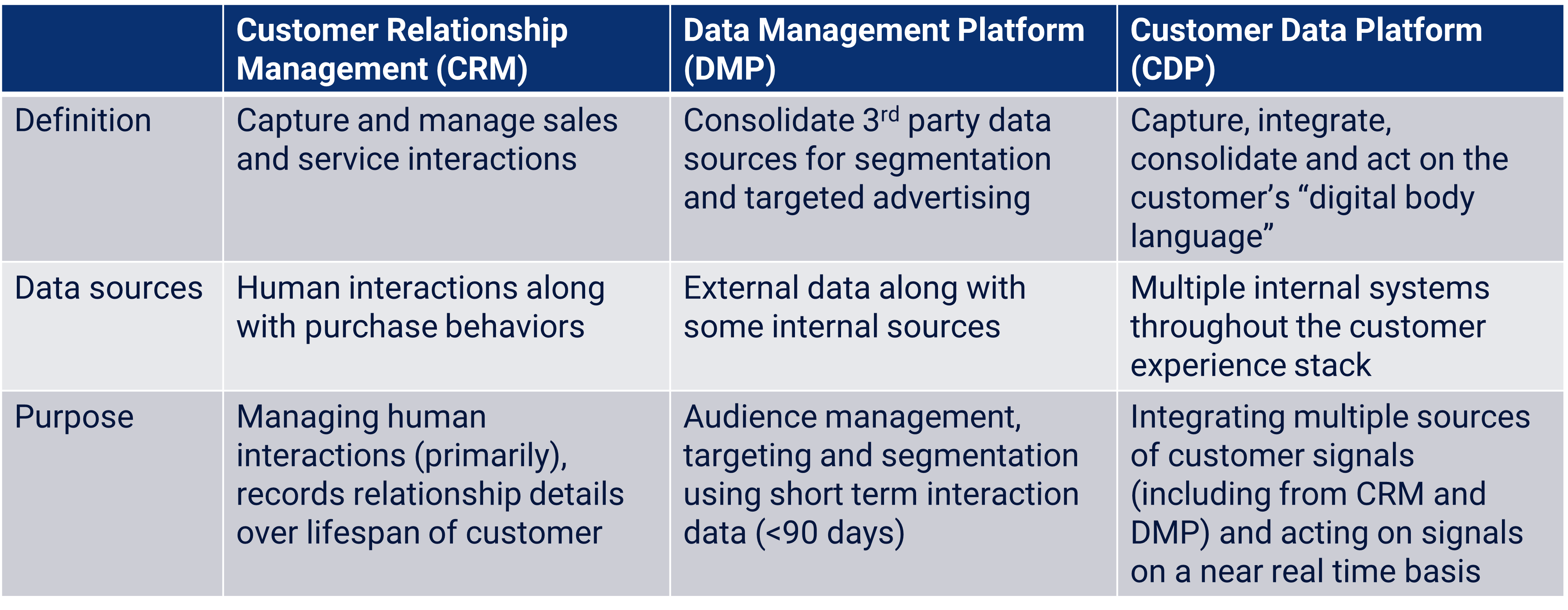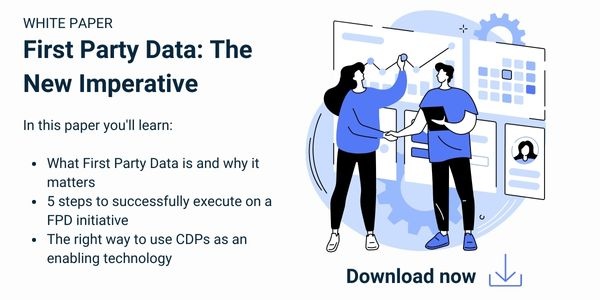Consumer concerns and new regulations have put purveyors and users of third party data on notice that this source of data may soon be extinct. With the advent of the General Data Protection Regulation (GDPR) and its California equivalent, the California Consumer Privacy Act (CCPA), and allegations of misuse of consumer data on social media platforms, companies must now focus on being transparent to users as to how they propose to use customer data, and obtain permission to use it. Several mobile operating systems and browser providers are phasing out cookies that have been used to track user behavior across the Internet.
The outcome is that many companies are focusing their attention on first party data, which they collect themselves rather than purchasing from aggregators. The ultimate goal is to use this rich source of digital body language to create personalized experiences that engage the customer and make it easier for them to identify products and services of interest. In order to get to this point, companies must understand the data they have and manage it well. They also need to know what they want to accomplish with their data.
Categories of data
Zero party data and first party data
Zero party data consists of information obtained directly from the customer, such as their contact information, their purchase history, and whether they participate in a loyalty program. Other zero party data includes age, gender, apparel size, and interests. It is provided by the customer either through actions they take (content downloaded, products purchased) or from surveys they opt to complete. All zero party information is obtained with the consent of the customer, and cannot be shared outside the company without permission and the choice to opt out.
First party data is information that includes zero party data, but adds another dimension: information that is derived from analysis of customer data, rather than being explicitly stated. For example, if a customer always uses a contact center rather than purchasing online, marketers can infer that the customer has a channel preference. Or analysis might reveal that the majority of the purchases are gifts for others. This information is derived from a company’s marketing ecosystem. Like zero party data, it cannot be shared outside the company without permission and the choice to opt-out.
Some data might fall into either category, depending on how it is collected. For example, if a customer states in a survey that they want flash sale notices texted to them versus emailed, that is zero party data. But if the merchandiser notices a preference from behavioral data without getting explicit input, then that is first party data.
It is helpful to have both zero and first party data because together they form a broader profile of the customer. In addition, customers’ behaviors do not always match their stated intentions. They might say one thing and do another. So sometimes zero and first party data conflict, and decisions must be made as to which should have priority. Nevertheless, whether the data is obtained directly from the customer or inferred from their digital body language, it allows personalization of future offers and ads, as well as “often bought together” recommendations for related products. As a result, customers should have a better and more efficient shopping experience, and companies should end up increasing revenue and customer satisfaction and therefore retention.
Second party data
Second party data is data that one organization has captured directly and sells to another. The seller is the originator of the data. These arrangements are developed in partnership and may involve an exchange of data or an outright sale. Marketplaces have been set up to facilitate these transactions. A content provider that publishes articles on a particular topic such as infant care can sell data about its readers to a company that sells baby products. The two groups of potential customers are likely to be similar but not identical, enabling both a broader view of individuals who share an interest, and possibly an extended base of customers.
Third party data
Third party data comes from aggregators who purchase data from other organizations and resell it. The data might be collected from multiple ecommerce websites, for example, and then sold to advertisers who want to target a particular segment of users.
This data is starting to be more heavily regulated. Organizations are taking such actions as eliminating cookies from their websites, as part of respecting individuals’ privacy and not running afoul of emerging regulations.
In addition, the data is much less reliable than first party data. One individual looked up her own records in the data sets of a third party supplier and found that she was a renter and a homeowner, was in four different income brackets, and was both a male and female head of household. The opportunities to resolve such conflicts are much less available than they would be with first party data.
Data capture and management
Companies that are planning on making more use of data about their customers have multiple options for capturing and managing the data.
 Customer relationship management (CRM) systems are designed for customer sales and service. They track leads, interactions with human salespeople and ecommerce systems, and generally operate over a long customer cycle.
Customer relationship management (CRM) systems are designed for customer sales and service. They track leads, interactions with human salespeople and ecommerce systems, and generally operate over a long customer cycle.
Data management platforms (DMPs) are used to consolidate third party data and other sources for segmentation and targeted advertising. They can include both internal and external data. They are often more of a snapshot in time, and use data sources such as cookies, which have a shorter lifespan.
Customer data platforms (CDPs) consolidate input from multiple sources and can act on data in near real time. CDPs capture behavioral data from digital touchpoints, including the Web, mobile devices, and email interactions.
Each type of system can play a role in capturing and managing data, and the benefits are greatest when they are orchestrated so the data becomes consolidated. CRMs typically do not aggregate data from various back end sources that contain customer data, or share it through other applications in the marketing technology stack via APIs or other means of integration. CDPs are the best option for getting a 360 degree view of the customer and a unified profile.
Metadata is an important element in these systems; each has its own metadata model, and often they are not harmonized. The CRM has models of the customer that include attributes such as the type of customer, type of business, and so on. The CDP that is aggregating the data may have a definition of the customer that is not in the CRM, perhaps specific to campaign management or email marketing.
Transforming data into business value
CDPs have particular value in transitioning to first party data, and can be transformative. They can improve first party data quality, and reduce the time required to go from customer insight to action. They also make testing smarter and more scalable. The final outcome is more timely and personalized cross-channel interactions.
To create a truly customized experience, it’s important to connect the customer to content in every context. Customer data may come from CRMs, email engagements, social media, and survey forms. The various contexts includes the person’s intent, location, and device they are using. Content may be products, blogs, events, or other relevant information that is provided to the customer. A complete data model allows you to connect the customer to the right content.
With Google phasing out tracking cookies, Apple changing to an opt-in policy with its latest operating system, and Facebook eliminating tracking of sensitive topics, third party data is waning. Contact us if you are ready to accelerate your ability to manage first party data and extract the greatest business value in order to stay competitive.

